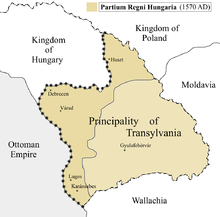Treaty of Speyer (1570)
The Treaty of Speyer, signed at the
Transylvania before the Treaty of Speyer
Unlike the autonomous
Status of Transylvania after the treaty

John Sigismund abdicated as King of Hungary, however, Maximilian II recognized John Sigismund's authority as "Prince of Transylvania" and, in return, John Sigismund accepted Maximilian II as King of Hungary with suzerainty over his principality.[4]
John Sigismund became princeps Transsylvaniae et partium regni Hungariae dominus – Prince of Transylvania and of a part of the Kingdom of Hungary.[5] According to the treaty, the Principality of Transylvania continued to be part of the Kingdom of Hungary in the sense of public law, the Treaty of Speyer stressed in a highly significant way that John Sigismund's possessions belonged to the Holy Crown of Hungary and he was not permitted to alienate them.[6]
This treaty, like the earlier Treaty of Nagyvárad, endorsed the principle of a united Hungary. Partium and Transylvania were entrusted to John Sigismund Zápolya, as a vassal of King Maximilian. As mentioned above, the Zápolyas had already held the Partium, but now the Habsburgs recognized their lordship. In a sense, John Sigismund traded his royal title for territory.
References
- ISBN 9780202366654. Archived from the originalon 2020-05-14.
- ISBN 9780192506436. Archived from the originalon 2020-05-14.
- ISBN 9780880334792. Archived from the originalon 2020-05-14.
- ^ Andrew Pettegree, The Reformation World, Routledge, 2000, p. 192
- ^ István Keul, Early modern religious communities in East-Central Europe: ethnic diversity, denominational plurality, and corporative politics in the principality of Transylvania (1526–1691), Brill, 2009, p. 61
- ^ Anthony Endrey, The Holy Crown of Hungary, Hungarian Institute, 1978, p. 70
